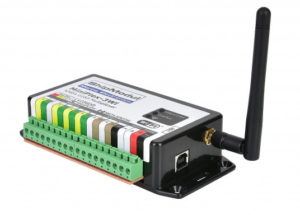NMEA 0183 is a marine serial communications standard. It defines a format for the transmission of GPS information, speed and course data, and other navigation data between navigation devices and other electronic devices on boats.
Benefits of NMEA 0183:
- Common: NMEA 0183 is a common standard supported by many legacy devices
- Ease of implementation: It is easy to develop a device for NMEA 0183 as there are simple protocols and a well-documented specification. The data is transmitted in ASCII and is easy to read, so that the functionality can be checked without much effort.
- Compatibility: Devices that support NMEA 0183 can communicate with each other, making it easier to integrate systems and share information.
- Expandability and openness: The NMEA0183 protocol can be expanded with your own data sets and does not require certification of the implementation. Any data sets can be integrated into NMEA0183 via XDR-Sentences.
- Simple implementation: Due to the low data rate, simple two-wire wiring systems can be used, which makes implementation easier. In addition, no special expensive connector systems are used and can be implemented with simple screw terminals.
- Long cables: The cable lengths can be up to 1000 m.
Disadvantages of NMEA 0183:
- Legacy Technology: NMEA 0183 is an older protocol and may be overtaken by more modern technologies such as NMEA 2000 or NMEA OneNet.
- Limited Data Capacity: NMEA 0183 has a limited capacity for transmitting data, especially when compared to more modern protocols. The standard initially only provided for speeds of 4800 Bd, but was gradually increased to 115200 Bd for some special applications.
- Connectivity: NMEA0183 is a point-to-point serial communication protocol. A data transmitter is always connected to one or more data receivers. Communication is always unidirectional. It cannot be sent and received at the same time.
- Bus systems: NMEA0183 can be implemented in various ways as a bus system (RS232, RS422, RS485, RS232-TTL). The multitude of possibilities increases the complexity when connecting to other systems. It is often not clear which implementation is involved. Resulting connection errors that are difficult to detect and fix.
- Data Security: NMEA 0183 does not have fault-tolerant security functionality, making it more vulnerable to data loss. Although the telegrams are provided with a checksum and errors can be detected, a faulty transmission cannot be resent.
Overall, NMEA 0183 is a useful standard for transmitting navigational data on boats, but it has limitations and cannot compete with more modern technologies in all applications. In order to be able to combine data from several data sources such as sensors into one data stream, there are so-called multiplexer.

Fig.: NMEA0183 gateway with WiFi converter (ship module)
The multiplexer receives various data telegrams at different ports and outputs the combined data stream from several sensors at a new data port. In this way, several sensor signals can be transmitted via a cable to a data terminal device such as a plotter or multifunction display. Many multiplexers also offer the option of separating certain data telegrams in the data stream with a filter function to suppress. For example, only the data that is really necessary can be transmitted to an autopilot, or ambiguities caused by multiple GPS receivers can be avoided.
Due to the simplicity of the NMEA0183 protocol, it can also be sent via TCP/IP or UDP telegrams and can therefore be used in LAN or WiFi networks. This compensates for some disadvantages such as the low data capacity and data security and NMEA0183 thus closes to more modern transmission technologies. Among other things, NMEA0183 via TCP/IP or UDP has established itself as the quasi-standard for data connections with third-party software.
Table of contents
hardware
NMEA0183 uses serial transmission. The hardware interface can be designed in different ways:
speed
The data transmission rates are between 4800…115200 Bd. A speed of 4800 Bd has been set as the standard for a two-wire line. From today's perspective, this speed is too slow for demanding applications. Therefore, the data rate has been increased to 9600 Bd or higher data rates. This means that GPS and AIS receivers can also transmit large amounts of data. The transmission frequency of the telegrams is between 1…10 Hz. However, it should be noted that the actual transmission speed can be influenced by various factors, such as the number of devices in the network, the type of data being transmitted and the length and Network cable quality. It may therefore be necessary in certain environments to adapt the data streams by filtering and dividing them into sub-networks in order to achieve the best possible transmission speed.
connection and connector
There is no precise specification for the connection technology and connectors for NMEA0183. Due to the robust transmission process, simple, unshielded two-wire cables can be used. Screw terminals have established themselves as the connection technology.
Application scenarios and limits
NMEA0183 is mainly used on older sensor devices. Due to the low data transmission rate, use is limited to sensors with low data throughput. Point-to-point communication requires the use of multiplexers when using multiple sensors. Because many hardware interfaces are permitted and work with different signal levels, connection problems often arise in practice, since it is often not clear which hardware interface is involved. NMEA0183 is rarely used in modern products and has been almost completely replaced by NMEA2000.
open-source
NMEA0183 is used in many open source applications because it is a very simple ASCII protocol is. There are a large number of DIY projects that support NMEA0183. Due to the easy expandability via XDR-Sentences, any additional sensor data can be added. NMEA0183 is also suitable for transmitting NMEA2000 information. There is a protocol extension called SeaSmart. At SeaSmart, NMEA2000 PGNs are transmitted as HEX data via special NMEA0183 telegrams. The NMEA2000 data is tunnelled, so to speak, in a different protocol. This means that NMEA2000 data can also be transmitted via Ethernet and WiFi. Timo Lappalainen supports in his NMEA2000 Lib the SeaSmart protocol.